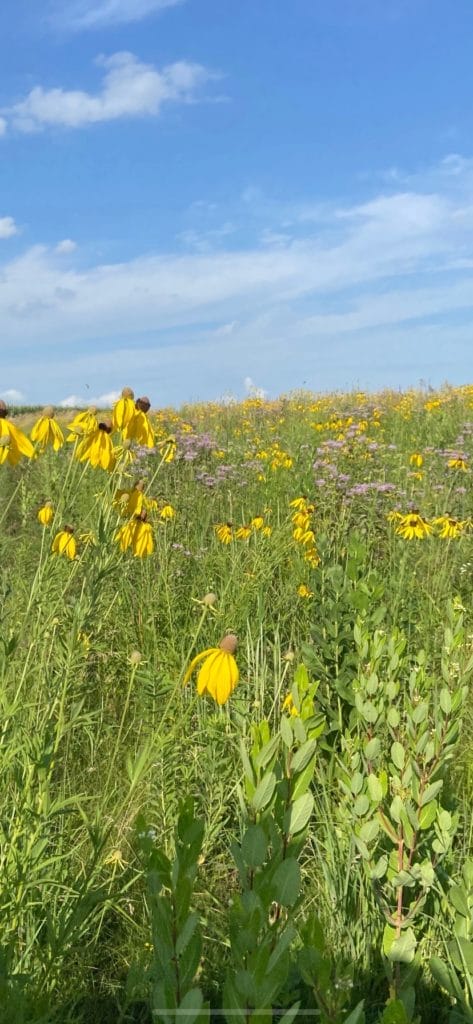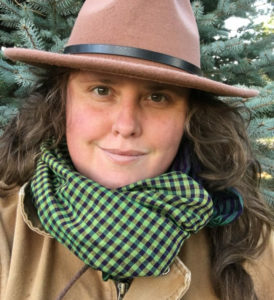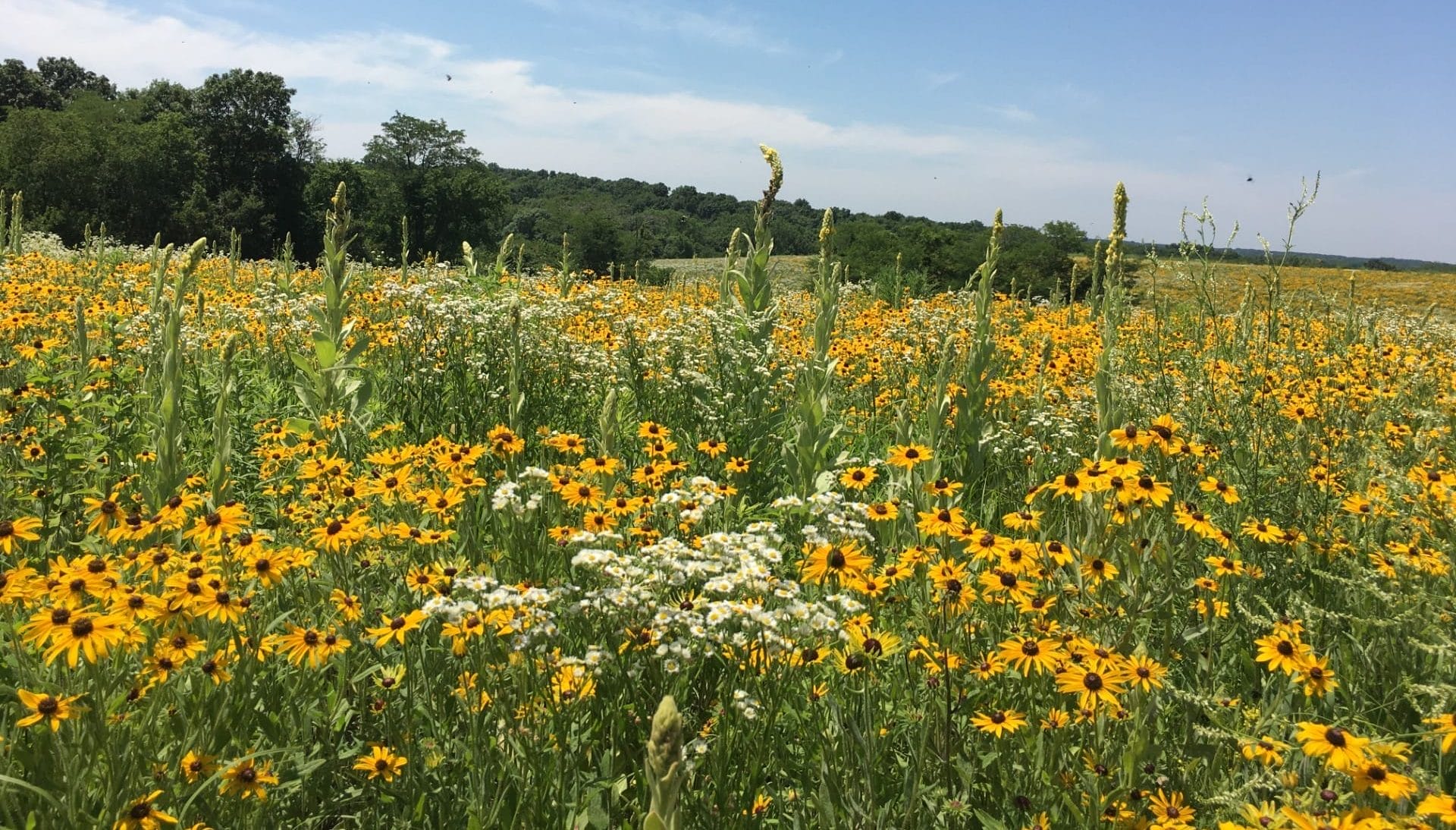Bringing the Buzz to Barnswallow Farm
A Tradition of Diversification
Meredith Nunnikhoven is owner and operator of Barnswallow Farm in Oskaloosa, Iowa. This sprawling 450-acre fresh cut flower farm, established in 2010, Barnswallow Farm offers private and open you-pick flower events, and hosts a variety of other events throughout the year, such as Ukrainian wreath making and floral arrangement workshops. Additionally, Meredith also runs a farm stay AirBnB and still maintaining some acres in traditional row crops. Needless to say, Meredith keeps herself plenty busy, but has remained adamant about supporting pollinator habitat over the years at Barnswallow Farm.
“We have 100 acres of native pollinator mix on the farm. We worked with Hoksey Native Seed as well as NRCS on the funding part. We definitely paid into it a little more on our end for that higher diversity type of seeding. The seed mixture we used has several hundred species of grasses, flowers and forbs. We were really striving for that diverse mix of seeds.”
Meredith credits this mindset toward diversity to her great-grandparents. They farmed and rotated through multiple crop types as well as having side enterprises not dependent on farm output. Diversifying their livelihood in this way got them through not only the Great Depression, but the farm crisis of the 1980’s as well. Meredith has harnessed that generational experience and knowledge and brought it to her own operations.
 “The 100-acres that we transitioned to pollinator habitat was basically unusable dirt. I took that lesson from my grandparents, to not let anything go to waste. With the varied mix we have out there right now, we are just letting it grow. It’s very survival of the fittest, but that is the best way to replicate a native prairie. Yarrow especially, is thriving in the field.”
“The 100-acres that we transitioned to pollinator habitat was basically unusable dirt. I took that lesson from my grandparents, to not let anything go to waste. With the varied mix we have out there right now, we are just letting it grow. It’s very survival of the fittest, but that is the best way to replicate a native prairie. Yarrow especially, is thriving in the field.”
Meredith has been greatly enjoying watching the natural progress of species succession on her farm. Those areas that are more low lying or prone to water retention are seeing high growth of milkweeds, while more elevated or well drained areas of Meredith’s prairie are rife with plants like Rudbeckia. On one ridge, melon grows happily where nothing else seems to be interested or capable of taking hold.
“My recommendation after doing this would be to plant a wide variety of species in a larger area. Then the species that like to inhabit various areas based on either the soil type or the moisture if its by trees, they will slowly naturalize and acclimate and choose where they want to live.”
A Return of Pollinators and Wildlife
Barnswallow Farm has seen a return of not only varied prairie plants, but of wildlife as well. Migratory birds such as Red-winged blackbirds, robins, Dark-eyed Junco’s and the Bobolink are often seen perching and nesting amongst the tall grasses of Meredith’s farm. “I love listening to their calls, many of which can go over several miles. It’s beautiful to listen to throughout the day and watching them flit around and stoop on the grasses.”
Where there is floral diversity, there is also the return of pollinators, and Barnswallow has certainly laid out the welcome mat for them. “It’s like a buzz factory and I even have what I am now calling a bee safari, where farm guests can go out and try to identify all the types of bees we now have. If you turn off your vehicle when you drive by the property, you can hear the buzzing from all the insects. It’s like an oasis for pollinators. An oasis we want to protect, and so we have a few buffer zones to separate us from some of the chemical use happening around us.”
Meredith worked closely with the Xerces Society, NRCS and local businesses, such as Hocksey Native Seed, to not only select her diverse mixture but come up with a plan to mitigate the risk of drift. Meredith states that working with each was easy going, informative and essential to developing a well-rounded conservation plan. Trees and ravines in particular have helped protect the pollinator habitat, but Meredith admits it was difficult to get in those tighter areas to seed. “We were just in these little tractors going round and round seeding this 100 acres, and this was the biggest area Hocksey had done, so it definitely took multiple days.”
One thing that Meredith stressed is to be okay with some failure. Both attempts she’s made to establish monarch habitats have failed. From mowing too much to not enough and having Brohm take over again, to flying on the seed mixture only to have it blow away or be eaten by birds, the whole process has been about learning what works and what doesn’t to get the colorful and diverse prairie that now exists. “We really needed to drill it in or roll it in, and it took working with several parties to finally figure that out, and that is the best advice I can give. Be willing to work with multiple parties and recognize that some things may not work out the first time, but it’s worth the work. Our family mission has always been to remain diversified. But as we’re going about that diversification that also means healing some of the possible mistakes or past regrets that we have as far as managing land right, and recognizing the type of land you have and what it can offer and being okay with that. And the whole idea of working with land and how we understand land has moved to a caretaking role and remembering we are owners on paper, but it’s never really ours and we should leave it better than we found it as part of our legacy.”
Did You Know?
Practical Farmers has funding available to help support the creation or enhancement of pollinator habitat on your farm. Apply for conservation cost-share to establish habitat for declining native pollinators in counties in the northeast quadrant of the state; this program can be implemented on farmland or remnant prairie habitat. The beneficial insects cost-share is also available throughout the state of Iowa for the creation of pollinator habitat.


